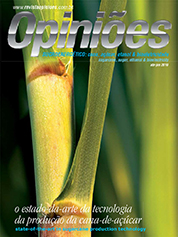Valter Casarin
Deputy Director of IPNI - International Plant Nutrition Institute no Brasil
Op-AA-24
Importance of macro and micro-nutrients in mineral nutrition of sugarcane
Nowadays, sugarcane represents one of Brazil’s largest agricultural markets. Set on an expansion course, the culture is expected to increase performance. Considering that sugarcane’s expansion is taking place mainly on less fertile soils, it becomes clear that the culture will heavily depend on mineral nutrition. The new varieties that are being launched, entailing higher productive potential, also show that sugarcane’s nutrition will be the limiting factor to achieve the intended perfor-mance levels.
The fertilizing of sugarcane requires the adequate and balanced supply of macro-nutrients (N, P, K, Ca, Mg and S) and micro-nutrients (B, Cl, Cu, Fe, Ni, Mn, Mo and Zn). Macro and micro-nutrients are essential elements for the development of sugarcane, given that they play vital roles in its metabolism. Nitrogen is a nutrient that for sugarcane is one of many compounds, mostly proteins, and consists of chlorophyll, organic acids and vegetal hormones.
A good supply of N favors a sugarcane plantation’s good development, fostering germination, root fixation and tiller dynamics. Phosphorous is part of the ATP and ADP molecules, therefore participating in all metabolic processes using energy. This element is also found in phospholipids and DNA and RNA molecules, taking part in cell division processes and the transmission of genetic characteristics.
Potassium fosters plant growth and tiller dynamics; it increases the content of carbohydrates, oils, lipids and proteins; it fosters sugar and starch storage; it helps in nitrogen fixation; it regulates the utilization of water and increases resistance to dryness, frost and molecules. Calcium is essential for the good development of the radicular system, because it plays an important role in root cell membrane formation.
Thus, its deficiency in soil solution influences growth of new developing roots, diminishing semi-permeability of the cell membrane, essential to the absorption of nutrients. Magnesium is a component of chlorophyll and also of several proteins. It also acts as an activator of a large number of enzymes involved in the metabolism of carbohydrates, in the synthesis of nucleic acids and enzymes acting on phosphorilated substrata.
Sulfur is essential to the synthesis of amino acids, proteins and vitamins (for example, biotin, thiamine and coenzyme A). Sulfidrile Groups (-SH) are usually a part of active enzyme molecule sites. Boron acts in the metabolism of carbohydrates and transportation of sugars through membranes; in nucleic acid synthesis (DNA and RNA) and of phytohormones; in the formation of cell membranes and in the division of cells.
Chloride acts in the breaking down of water molecules in photosynthesis II and as an enzyme activator. The content of certain amino acids and starches is extraordinarily high in chloride-deficient plants, and hence, synthesis inhibition or protein degradation occurs. Copper plays an important role in the photosynthesis process, acting in the transportation of electrons through plastocianine.
In the breathing process it acts in terminal oxydation through citrochome oxydasis. It also increases the resistance to diseases and acts in protein synthesis. It is a component of ascorbic acid oxydase, tirosinase, monoamine oxydase, urate oxydase, citrochome oxy-dase, phenolase, laccase and plastocianine. Iron plays an important role in the formation of chlorophyll and in the metabolism of nucleic acids.
It acts in proteins of heme and non-heme groups (reduction of nitrates and sulfates). It has catalytic and structural functions. Manganese plays an important role in photosynthesis, given that it is present in the structuring, functioning and multiplication of chloroplasts and acts in the transportation of electrons. It is a needed element in the activation of some enzymes such as dehydrogenases, decarboxilases, kinases, oxydases e peroxydases.
Molybdenum acts in the metabolism of nitrogen, bringing about an increase in nitrogenated nutrition, and hence, an increase in the production of saccharose. In the case of sugarcane, a plant that can extract nitrogen from nitrate in the soil and/or through the biological fixation process using diazothrophic bacteria, molybdenum is a factor in making better use of nitrogenated nutrition.
In biological systems, molybdenum com-prises some enzymes that catalyze reations, whereas in plants one can refer to nitrate reductase, nitrogenase and oxydase sulfite enzymes. Zinc acts in the synthesis of the growth hormone (AIA) because of its activation of tryptophane synthetase enzymes and the metabolism of tryptamine. The element zinc comprises alcohol dehydrogenase, glutamate dehydrogenase, carbonic anydrase, etc.
Although silicon is not considered a nutrient of the essential or functional group for plant growth, its application has shown productivity increases in sugarcane plantations. Silicon, after it is absorbed, is deposited mainly on the cell membrane of the epidermis, substantially contributing to strengthening resistance to bedding and the attack of pests and diseases.




